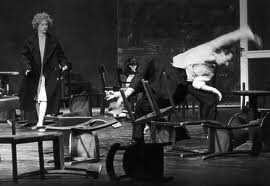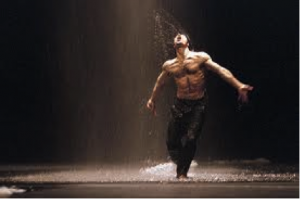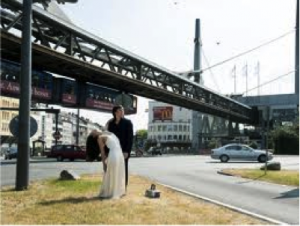
Pina: The Movie
Pina is an extraordinary film, an inspiring 3D ‘documentary’ that should be mandatory viewing for anyone who doesn’t get modern dance (i.e.99% of Americans). In Pina, Wim Wenders (Wings of Desire) tackles dance, art, collaboration, and grief, with gusto and grace, a fitting homage to the great German choreographer Pina Bausch. Run out and see it tonight because it won’t be in theatres long- the marketing for this film has been non-existent. It may be your only chance to see something genuine all year.
“Dance, dance, or we are lost.”
Pina Bausch was one of the great artists of our time. If you’ve never heard of her, you’re not alone- in the U.S. she remains criminally unknown outside of dance circles. She emerged onto the world stage in the 70’s and worked relentlessly until her death in ’09. The first time I saw her work was The Window Washer at BAM in 1998. Dancers skied down a mountain of blood red carnations, other swung from fly lines- it was a mind-blowing collage of motion and stillness, exuberant splendor and precision, wit and sorrow that has never ceased playing in my mind. Her work was an assault on expectations- aggressively pacing the treacherous line between terror and hilarity. Bausch sought to provoke and engage without ever alienating her audience.

Bausch was a pure artist. She drew from every medium, was relentlessly creative, and had the rare ability to both shock and inspire by bringing an audience to something it can barely comprehend, yet intuitively understands and desires. She sought dancers who were as varied as instruments in an orchestra. As we see in the film, they’re old, young, tall, short, from all over the globe. As one dancer says, “We were colors on her canvas”. Her work avoided the monotonous tropes of modern dance- the opaque inversion of Graham, the cold intellectualism of Cunningham, the cloying theatricality of Ailey. By contrasting danger and humor, stillness and motion, the human body and inanimate props, she leveraged her way to the heart of the matter. Her talent is perhaps best illustrated in the famous Café de Muller (re-staged marvelously in Pina), in which a woman with eyes shut tight runs blindly across a stage filled with chairs, while a man rushes desperately in front of her to clear the chairs from her path. The physical danger, absurdity, humor, and shock of all of this was ground breaking and polarized critics of the time (another sign of her artistic quality).

It is no wonder that the ambitious Wim Wenders sought her out, famously decreeing that he had found in her work a fitting vehicle for 3D. Tragically, Bausch unexpectedly died mid-production. It’s unlikely that anyone but Mr. Wenders (with the possible exception of Werner Herzog) could have snatched this film from the jaws of this unforeseen cataclysm. But succeed he does, on at least three crucial levels:
HE EVOKES DANCE in an original and powerful way. Wenders is not so naïve as to think he can capture dance. Instead, he uses the emotional tools of cinema to draw the audience into the world of the dancers; he wants you to feel and appreciate what they’re doing. He makes you want to dance. Generally speaking, dance is an exquisitely ephemeral, non-liner, non-intellectual art form, full of athleticism and vitality. Faced with this, most film directors cower behind rapid-fire editing and blasting scores- think of virtually every dance scene put on film since the 80’s. Wenders gleefully grapples with this riddle: he gives the wide angle, then takes the camera on stage, he follows dancers, he pivots and holds shots for long stretches, and grabs the occasional close up. We hear the dancers breathe, watch them sweat, see them covered in dust, dirt, and water. Speaking as a dancer, I can say that he effectively conveys the immense skill and dedication of these dancers, some of the best you will ever see. He intercuts pieces, much as Pina herself did, returning to themes and sub-themes within the larger movements. He takes us out of doors- to rock quarries, subways, traffic islands, and forests. Though the film is loosely structured around four of her major works, we often see smaller pieces- the Godzilla woman smashing a pillow on the train, or the happy dancing clown who is being attacked by the little dog, the woman sighing as she cascades over chairs. In this way he keeps us engaged and ties together the larger themes. We feel the dances because Wenders uses cinema’s emotional power and Pina’s own tragic death as a way to make us empathize with the dancers themselves.

HE CREATES A POWERFUL HOMAGE without descending to cliché or nostalgia. Following the writers’ dictum, Wenders, shows us about Pina, rather than telling. He intercuts ‘interviews’ which, in lieu of talking heads, show Pina’s dancers silently facing the camera. We hear them in voice over briefly explain their relationship with Pina and dance, and sometimes there’s no voice over at all. This is fitting. As Bausch quipped, “Dance says what words cannot”. As our familiarity with the troupe grows, each successive dance gains emotional power, and we become acutely aware of what is missing: Pina Bausch. She is only seen fleetingly in old footage, which feels appropriate: she exists now only in documents, in her dances, and the memories and movements of her dancers.

HE USES 3D WELL. I never thought I’d say that. I hate 3D. I see glowing spheres for hours afterward, my head aches, and I consider the whole thing to be as stupid and contrived as Kim Cardashian, a scam foisted on directors and now on us, the hapless audience. Pina could play fine without 3D, but for the first time I appreciated this artificial depth device. Wenders uses 3D to bring us closer to the kinetic power of movement and to create the layered, theatrical feel that works on an almost meta-documentary level. It’s like watching a film through an old school viewfinder. The 3D tool, for the first time that I’ve seen, suits the material. His shots are full of depth and layered blocking, they resonate with movement and stillness, absurdity and beauty, surprise and charm. Again, Wenders wisely takes his cues from Pina herself.

For all the cynical film goers out there (and that’s most of us over the age of fourteen), this film just might revitalized and inspire you. For the first time in a long, long time, a director makes dance seem alive, vital, and emotional. No less than six times did I look around the theatre to find the entire audience weeping (myself included). Terror, humor, pathos, power- that was Bausch and that is Pina.

